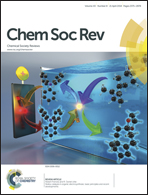The role of “disaggregation” in optical probe development
Abstract
“Aggregation-caused signal change” is a well-established mechanism by now and has been widely used as the basis for optical probe and sensor development. Compared to aggregation, its reverse process, disaggregation, has received much less attention and is not properly discussed in the literature so far. With the less established paradigm or mechanism, although some of the reported sensors and probes seem to work through disaggregation phenomena, the proper interpretation of the results and applying the concept to novel probe development is seriously hampered. The process from aggregation to disaggregation generally causes a recovery or enhancement of fluorescence signals, and thus provides an interesting new path to design “turn-on” probes. This tutorial review will provide the balanced comparison between aggregation and disaggregation mechanism, and focuses on the less explored advantages of “disaggregation” as a novel sensing mechanism and its recent applications in probe development.


 Please wait while we load your content...
Please wait while we load your content...